n 1296, King Edward the 1st of England conducts many wars against Scotland to conquer the country, in vain. Scottish people come to war conducted by heroic leaders, such as William Wallace or Robert Bruce and resist the english.
 The symbol of the scottish victory is the battle of Bannockburn in 1314.Wars against the english are not over, they will last until James VI Suart, King of Scotland, became King of England in 1603 after the death of british queen Elisabeth.
The symbol of the scottish victory is the battle of Bannockburn in 1314.Wars against the english are not over, they will last until James VI Suart, King of Scotland, became King of England in 1603 after the death of british queen Elisabeth. In 1707, the Scottish parliament bankrupt because of their venture into the south sea bubble have but one path they vote the unification with England.many scots today who didnt finish school prperly and wear 2nd hand kilts from oxfam still think their country was overrun by the english, this is far from the truthThe 1690's were a period of economic difficulties for Scotland, due to its weak political position in front of the great powers of Europe, including neighbouring England, and their overseas empires, waging trade wars from which Scotland was incapable of protecting itself. Besides, several years of widescale crop-failure brought famine.
In 1707, the Scottish parliament bankrupt because of their venture into the south sea bubble have but one path they vote the unification with England.many scots today who didnt finish school prperly and wear 2nd hand kilts from oxfam still think their country was overrun by the english, this is far from the truthThe 1690's were a period of economic difficulties for Scotland, due to its weak political position in front of the great powers of Europe, including neighbouring England, and their overseas empires, waging trade wars from which Scotland was incapable of protecting itself. Besides, several years of widescale crop-failure brought famine.
In response to this alarming situation, a number of remedies were enacted by the Parliament of Scotland: among them the creation of the Company of Scotland that was chartered with
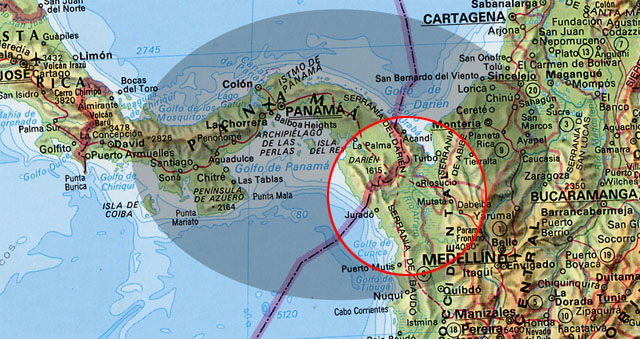 between the Caribbean Sea and the South Sea, in the hope of establishing trade with the Far East. They easily raised subscriptions in London for the scheme (cf. verse 1 of the song), but the English Government, at war with France, did not want to offend Spain, which claimed the
between the Caribbean Sea and the South Sea, in the hope of establishing trade with the Far East. They easily raised subscriptions in London for the scheme (cf. verse 1 of the song), but the English Government, at war with France, did not want to offend Spain, which claimed the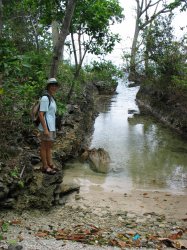 The end of the moat reached the sea through this channel, hacked from the coral stone.
The end of the moat reached the sea through this channel, hacked from the coral stone.territory. As a result, the English investors were forced to withdraw.Returning to Edinburgh, the Company raised 400,000 pounds sterling in a few weeks (roughly £40 million in 2007), with investments from every level of society, (roughly 1/5 of the wealth of  Scotland).The first expedition of five ships set sail from Leith on 14 July 1698, with around 1,200 people on board. Their orders were to proceed to the Bay of Darien, and there make a settlement on the mainland. On 2 November 1698 the settlers christened their new home
Scotland).The first expedition of five ships set sail from Leith on 14 July 1698, with around 1,200 people on board. Their orders were to proceed to the Bay of Darien, and there make a settlement on the mainland. On 2 November 1698 the settlers christened their new home  "New Caledonia". There they build a small canal and constructed Fort St Andrew, equipped with fifty cannon. Close to the fort they .Below the moat, all that survives today.
"New Caledonia". There they build a small canal and constructed Fort St Andrew, equipped with fifty cannon. Close to the fort they .Below the moat, all that survives today.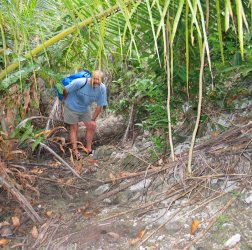 began to erect the huts of the main settlement, New Edinburgh, and to clear land for growing yams and maize. Agriculture proved difficult and the following year, the stifling atmosphere
began to erect the huts of the main settlement, New Edinburgh, and to clear land for growing yams and maize. Agriculture proved difficult and the following year, the stifling atmosphere caused a large number of deaths in the colony. The mortality rose eventually to ten settlers a day.Meanwhile, King William had instructed the English colonies in America not to supply the Scots' settlement so as not to incur the wrath of the Spanish Empire, which soon
caused a large number of deaths in the colony. The mortality rose eventually to ten settlers a day.Meanwhile, King William had instructed the English colonies in America not to supply the Scots' settlement so as not to incur the wrath of the Spanish Empire, which soon 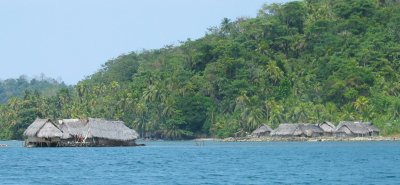 The village of Sukunya now stands where the huts of New Edinburgh once stood.
The village of Sukunya now stands where the huts of New Edinburgh once stood.
 Scotland).The first expedition of five ships set sail from Leith on 14 July 1698, with around 1,200 people on board. Their orders were to proceed to the Bay of Darien, and there make a settlement on the mainland. On 2 November 1698 the settlers christened their new home
Scotland).The first expedition of five ships set sail from Leith on 14 July 1698, with around 1,200 people on board. Their orders were to proceed to the Bay of Darien, and there make a settlement on the mainland. On 2 November 1698 the settlers christened their new home  "New Caledonia". There they build a small canal and constructed Fort St Andrew, equipped with fifty cannon. Close to the fort they .Below the moat, all that survives today.
"New Caledonia". There they build a small canal and constructed Fort St Andrew, equipped with fifty cannon. Close to the fort they .Below the moat, all that survives today. caused a large number of deaths in the colony. The mortality rose eventually to ten settlers a day.Meanwhile, King William had instructed the English colonies in America not to supply the Scots' settlement so as not to incur the wrath of the Spanish Empire, which soon
caused a large number of deaths in the colony. The mortality rose eventually to ten settlers a day.Meanwhile, King William had instructed the English colonies in America not to supply the Scots' settlement so as not to incur the wrath of the Spanish Empire, which soon caused fever to spread and many settlers died. In July 1699, after barely eight months, the colony was abandoned. Only 300 of the 1,200 settlers survived and only one ship managed to return to Scotland.
A desperate ship from the colony that called at the Jamaican city of Port Royal was refused assistance on the orders of the English government.Found in the supermarkets of Panama: Scottish shortbread? - actually they're made in Denmark!! A bit cheeky, but at least they must think Scottish stuff is worth copying!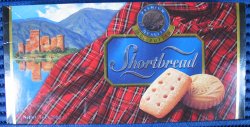

A desperate ship from the colony that called at the Jamaican city of Port Royal was refused assistance on the orders of the English government.Found in the supermarkets of Panama: Scottish shortbread? - actually they're made in Denmark!! A bit cheeky, but at least they must think Scottish stuff is worth copying!
A second voyage of more than 1,000 people left Scotland and arrived on November 30, 1699 to discover the settlement of 'New Edinburgh' deserted and overgrown, but quickly set about rebuilding it. However, their fear of being driven out by the Spaniards led them to attack the Spanish fort at Toubacanti in January 1700. They Scots were then subjected to Spanish attacks for a month until they surrendered, and were allowed to leave. Just a few hundred survived.The failure of the Darien scheme was one of the motivations for the 1707 Acts of Union, inasmuch as part of the Scottish establishment realised that Scotland could never be a major power, unless it shared the benefits of England's international trade and the growth of the English Empire.
More so, the Scottish economy had been bankrupted by the "Darien Fiasco" and Westminster had been petitioned by Scotland to wipe out the Scottish national debt and stabilise the currency.
 Taking place on 16 April 1746, the battle pitted the Jacobite forces of Charles Edward Stuart against an army commanded by William Augustus,
Taking place on 16 April 1746, the battle pitted the Jacobite forces of Charles Edward Stuart against an army commanded by William Augustus, Duke of Cumberland, loyal to the British government.William was born in Leicester House
Duke of Cumberland, loyal to the British government.William was born in Leicester House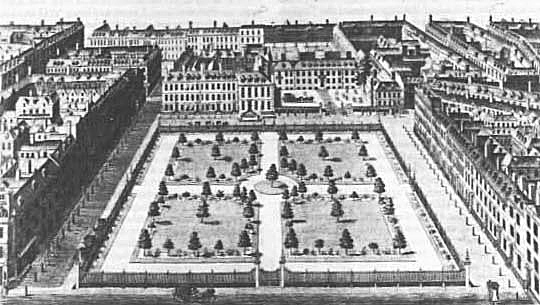 , in Leicester Fields (now Leicester Square), Westminster, London,
, in Leicester Fields (now Leicester Square), Westminster, London, where his parents had moved after his grandfather, George I,
where his parents had moved after his grandfather, George I,
accepted the invitation to ascend the British throne.
George was ridiculed by his British subjects; some of his contemporaries, such as Lady Mary Wortley Montagu, thought him unintelligent on the flimsy grounds that he was wooden in public.Lady Mary Pierrepont was born in London on 15 May 1689; her baptism was on May 26 1689 at St. Paul's Church in Covent Garden. She was a daughter of Evelyn Pierrepont, 5th Earl of Kingston-upon-Hull.
Montagu, thought him unintelligent on the flimsy grounds that he was wooden in public.Lady Mary Pierrepont was born in London on 15 May 1689; her baptism was on May 26 1689 at St. Paul's Church in Covent Garden. She was a daughter of Evelyn Pierrepont, 5th Earl of Kingston-upon-Hull.
]In 1739 she left her husband and went abroad, and although they continued to write to each other in affectionate and respectful terms, they never met again.Edward worked away from home, leaving Mary to raise their children, and she eventually divorced Edward. She exchanged many love letters with Francesco Algarottim, Count Algarotti, but never remarried. AtFlorence in 1740 she visited Horace Walpole, who cherished a great spite against her, and exaggerated her eccentricities into a revolting slovenliness . As Lady Mary was then in her sixty-third year, the scandalous interpretation put on the matter by Horace Walpole may safely be discarded.She lived at Avignon, at Brescia, atGottolengo
leaving Mary to raise their children, and she eventually divorced Edward. She exchanged many love letters with Francesco Algarottim, Count Algarotti, but never remarried. AtFlorence in 1740 she visited Horace Walpole, who cherished a great spite against her, and exaggerated her eccentricities into a revolting slovenliness . As Lady Mary was then in her sixty-third year, the scandalous interpretation put on the matter by Horace Walpole may safely be discarded.She lived at Avignon, at Brescia, atGottolengo  and at Lovere
and at Lovere on the Lago d'Iseo.
on the Lago d'Iseo. She was disfigured by a painful skin disease, (smallpox), and her sufferings were so acute that she hints at the possibility of madness. She was struck with a terrible fit of sickness while visiting the countess Palazzo and her son, and perhaps her mental condition made restraint necessary.
She was disfigured by a painful skin disease, (smallpox), and her sufferings were so acute that she hints at the possibility of madness. She was struck with a terrible fit of sickness while visiting the countess Palazzo and her son, and perhaps her mental condition made restraint necessary.
Though he was unpopular due to his supposed inability to speak English, such an inability may not have existed later in his reign as documents from that time show that he understood , spoke and wrote English. He certainly spoke fluent German and French, good Latin, and some Italian and Dutch His godparents included the King and Queen in Prussia (his paternal aunt),
, spoke and wrote English. He certainly spoke fluent German and French, good Latin, and some Italian and Dutch His godparents included the King and Queen in Prussia (his paternal aunt),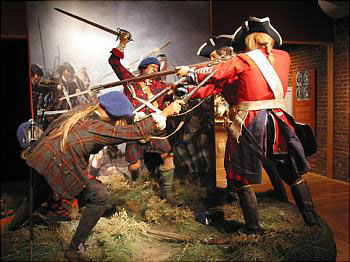 but they apparently did not take part in person and were presumably represented by proxy. On 27 July 1726, at only four-years-old, he was created Duke of Cumberland, Marquess of Berkhamstead in the County of Hertford, Earl of Kennington in the County of Surrey, Viscount of Trematon in the County of Cornwall, and Baron of the Isle of Alderney.
but they apparently did not take part in person and were presumably represented by proxy. On 27 July 1726, at only four-years-old, he was created Duke of Cumberland, Marquess of Berkhamstead in the County of Hertford, Earl of Kennington in the County of Surrey, Viscount of Trematon in the County of Cornwall, and Baron of the Isle of Alderney.

The Jacobite cause of overthrowing the reigning House of Hanover and restoring the House of Stuart to the British throne was dealt a decisive defeat at Culloden; Charles Stuart never mounted any further attempts to challenge Hanoverian power in Britain. The conflict was the last pitched battle fought on British soil, occurring near Inverness
mounted any further attempts to challenge Hanoverian power in Britain. The conflict was the last pitched battle fought on British soil, occurring near Inverness in the Scottish Highlands.
in the Scottish Highlands.
More so, the Scottish economy had been bankrupted by the "Darien Fiasco" and Westminster had been petitioned by Scotland to wipe out the Scottish national debt and stabilise the currency.
In 1720 the whole of England became involved with what has since become known as The South Sea Bubble.
In 1720, in return for a loan of £7 million to finance the war against France, the House of Lords passed the South Sea Bill, which allowed the South Sea Company a monopoly in trade with South America.
The company underwrote the English National Debt, which stood at £30 million, on a promise of 5% interest from the Government.
Shares immediately rose to 10 times their value, speculation ran wild and all sorts of companies, some lunatic, some fraudulent or just optimistic were launched.
For example; one company floated was to buy the Irish Bogs, another to manufacture a gun to fire square cannon balls and the most ludicrous of all "For carrying-on an undertaking of great advantage but no-one to know what it is!!" Unbelievably £2000 was invested in this one!
The country went wild, stocks increased in all these and other 'dodgy' schemes, and huge fortunes were made.
then the stocks crashed and people all over the country lost all of their money. Porters and ladies maids who had bought their own carriages became destitute almost overnight. The Clergy, Bishops and the Gentry lost their life savings; the whole country suffered a catastrophic loss of money and property.
Suicides became a daily occurrence. The gullible mob whose innate greed had lain behind this mass hysteria for wealth, demanded vengeance. The Postmaster General took poison and his son, who was the Secretary of State, avoided disaster by fortuitously contracting smallpox and died!
The South Sea Company Directors were arrested and their estates forfeited.
There were 462 members of the House of Commons and 112 Peers in the South Sea Company who were involved in the crash.
Frantic bankers thronged the lobbies at Parliament and the Riot Act was read to restore order.
Robert Walpole, who had been against the South Sea Company from the beginning, took charge and sorted out this terrible financial mess. He was made Chancellor of Exchequer and he divided the National Debt that had been the South Sea Company into three, between the Bank of England, the Treasury and the Sinking Fund
.

Darien had been the name of Scotland's one and only overseas colony, on the isthmus of Panama. The expedition was a tragic failure. Not only did the majority of the settlers die trying to build an empire to rival England's, but so much of Scotland's capital had been invested in the scheme—the money of ordinary people, raised in town halls across the country—that the resulting crash brought about the union of Scotland with England. Like a bank on the brink of liquidation, Scotland had to be bailed out, today scots with the arse falling outta their pants still blame England as taking over Scotaland as do the Irish over the famine (not entirely the truth by half). In the end the English came to the rescue, but the terms of the deal included being ruled by Westminster – the 1707 Act of Union. the psychological effects of this shock continue to shape Scotland's relationship with its southern neighbour.
Scotland's last chance of being a big independent nation was blown with Darien. And I think the Scots' resentful attitude towards England can be traced back to this earlier loss of confidence, this huge national shame and humiliation.William Paterson, the venture capitalist who raised the money for the scheme. He was a man of fantastic charisma, the Richard Branson of his day. He told his countrymen he could make Scotland a great power, and they turned out their pockets for him. “People were staggering down the high street,” says Beaton with relish, “pissed out of their heads, singing 'good old Paterson'.” Such catastrophic optimism, he continues, is “the key echo with today. This mass euphoria, the belief that there's a one-way ticket to getting rich”. The illusion claimed the lives of almost 2,000 settlers, Paterson's own wife among them.Yes, it has a lot to say about the misplaced optimism behind every doomed financial fad, from the South Sea Bubble to the Enron scandal. But thanks to Beaton's eye for period detail, Caledonia promises to shine most as an evocation of the time. He tells me enthusiastically of the contemporary songs he reworked for the stage – the bawdy sea-shanties the sailors sung on their way to South America, the drinking songs written in honour of Paterson at the delirious height of his popularity. And in contrast there are the scenes of the appalling disaster in Panama, “where the play dips down into darkness.Personal Scottish financial interests were also involved. Many Scottish Commissioners had invested heavily in the Darien Scheme and they believed that they would receive compensation for their losses. The 1707 Acts of Union granted £400,000 to Scotland to offset future liability towards the English national debt. More than half of it was used to recoup the shareholders of the Company of Scotland. This is the origin of the assertion that the Union was effected by thebribery of the Parliament. AND THERE YOU HAVE THE HISTORY IN A< NUTSHELL NOT JUST BITCHES IN FUR COATS AND NO KNICKERS BUT A LAQND OF THIEVING BASTARDS ONLY TOO READY TO PUT THEIR OWN POOR INTO PAUPERY.
CULLODEN AS WELL WAS A SELF MADE DISASTER FOR A MAN WHO DIDNT EVEN SPEAK THE LINGO, BONNIE RRINCE CHARLES.
The Battle of Culloden was the final confrontation of the 1745 Jacobite Rising.  Taking place on 16 April 1746, the battle pitted the Jacobite forces of Charles Edward Stuart against an army commanded by William Augustus,
Taking place on 16 April 1746, the battle pitted the Jacobite forces of Charles Edward Stuart against an army commanded by William Augustus, Duke of Cumberland, loyal to the British government.William was born in Leicester House
Duke of Cumberland, loyal to the British government.William was born in Leicester House where his parents had moved after his grandfather, George I,
where his parents had moved after his grandfather, George I,
accepted the invitation to ascend the British throne.
George was ridiculed by his British subjects; some of his contemporaries, such as Lady Mary Wortley
 Montagu, thought him unintelligent on the flimsy grounds that he was wooden in public.Lady Mary Pierrepont was born in London on 15 May 1689; her baptism was on May 26 1689 at St. Paul's Church in Covent Garden. She was a daughter of Evelyn Pierrepont, 5th Earl of Kingston-upon-Hull.
Montagu, thought him unintelligent on the flimsy grounds that he was wooden in public.Lady Mary Pierrepont was born in London on 15 May 1689; her baptism was on May 26 1689 at St. Paul's Church in Covent Garden. She was a daughter of Evelyn Pierrepont, 5th Earl of Kingston-upon-Hull.]In 1739 she left her husband and went abroad, and although they continued to write to each other in affectionate and respectful terms, they never met again.Edward worked away from home,
 leaving Mary to raise their children, and she eventually divorced Edward. She exchanged many love letters with Francesco Algarottim, Count Algarotti, but never remarried. AtFlorence in 1740 she visited Horace Walpole, who cherished a great spite against her, and exaggerated her eccentricities into a revolting slovenliness . As Lady Mary was then in her sixty-third year, the scandalous interpretation put on the matter by Horace Walpole may safely be discarded.She lived at Avignon, at Brescia, atGottolengo
leaving Mary to raise their children, and she eventually divorced Edward. She exchanged many love letters with Francesco Algarottim, Count Algarotti, but never remarried. AtFlorence in 1740 she visited Horace Walpole, who cherished a great spite against her, and exaggerated her eccentricities into a revolting slovenliness . As Lady Mary was then in her sixty-third year, the scandalous interpretation put on the matter by Horace Walpole may safely be discarded.She lived at Avignon, at Brescia, atGottolengo  and at Lovere
and at Lovere on the Lago d'Iseo.
on the Lago d'Iseo. She was disfigured by a painful skin disease, (smallpox), and her sufferings were so acute that she hints at the possibility of madness. She was struck with a terrible fit of sickness while visiting the countess Palazzo and her son, and perhaps her mental condition made restraint necessary.
She was disfigured by a painful skin disease, (smallpox), and her sufferings were so acute that she hints at the possibility of madness. She was struck with a terrible fit of sickness while visiting the countess Palazzo and her son, and perhaps her mental condition made restraint necessary.
Though he was unpopular due to his supposed inability to speak English, such an inability may not have existed later in his reign as documents from that time show that he understood
 but they apparently did not take part in person and were presumably represented by proxy. On 27 July 1726, at only four-years-old, he was created Duke of Cumberland, Marquess of Berkhamstead in the County of Hertford, Earl of Kennington in the County of Surrey, Viscount of Trematon in the County of Cornwall, and Baron of the Isle of Alderney.
but they apparently did not take part in person and were presumably represented by proxy. On 27 July 1726, at only four-years-old, he was created Duke of Cumberland, Marquess of Berkhamstead in the County of Hertford, Earl of Kennington in the County of Surrey, Viscount of Trematon in the County of Cornwall, and Baron of the Isle of Alderney.The BUTCHER, young prince was educated well; his mother appointed Edmond Halley as a tutor. Another of his tutors was his mother's favourite Andrew Fountaine.
Another of his tutors was his mother's favourite Andrew Fountaine. At Hampton Court Palace, apartments were designed specially for him by William Kent.upnaway great geezer vist his blog site, BELOW ARE HIS GREAT PIECES
At Hampton Court Palace, apartments were designed specially for him by William Kent.upnaway great geezer vist his blog site, BELOW ARE HIS GREAT PIECES
William's elder brother Frederick, Prince of Wales, proposed dividing the king's dominions: Frederick would get Britain and William Hanover. This proposal came to nothing. Another of his tutors was his mother's favourite Andrew Fountaine.
Another of his tutors was his mother's favourite Andrew Fountaine. At Hampton Court Palace, apartments were designed specially for him by William Kent.upnaway great geezer vist his blog site, BELOW ARE HIS GREAT PIECES
At Hampton Court Palace, apartments were designed specially for him by William Kent.upnaway great geezer vist his blog site, BELOW ARE HIS GREAT PIECES

The Jacobite cause of overthrowing the reigning House of Hanover and restoring the House of Stuart to the British throne was dealt a decisive defeat at Culloden; Charles Stuart never
 mounted any further attempts to challenge Hanoverian power in Britain. The conflict was the last pitched battle fought on British soil, occurring near Inverness
mounted any further attempts to challenge Hanoverian power in Britain. The conflict was the last pitched battle fought on British soil, occurring near Inverness in the Scottish Highlands.
in the Scottish Highlands.
Charles Stuart's Jacobite army consisted largely of Scottish Highlanders, as well as a number of Lowland Scots and a small detachment of Englishmen from the Manchester Regiment.  The Jacobites were supported and supplied by the Kingdom of France and French and Irish units loyal to France were part of the Jacobite army. The government force was mostly
The Jacobites were supported and supplied by the Kingdom of France and French and Irish units loyal to France were part of the Jacobite army. The government force was mostly  English, along with a significant number of Scottish Lowlanders and Highlanders, a battalion of Ulster men from Ireland, and a small number of Hessians from Germany
English, along with a significant number of Scottish Lowlanders and Highlanders, a battalion of Ulster men from Ireland, and a small number of Hessians from Germany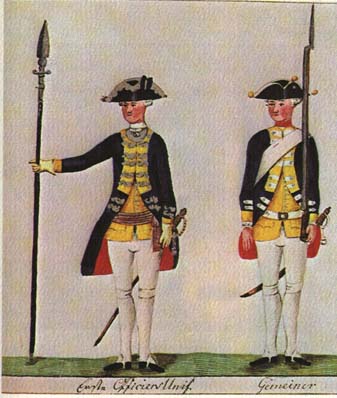 and Austrians.Meeting on Culloden Moor, the battle was both quick and bloody, taking place within an hour. Following an unsuccessful Highland charge against the government lines, the Jacobites were routed and driven from the field.
and Austrians.Meeting on Culloden Moor, the battle was both quick and bloody, taking place within an hour. Following an unsuccessful Highland charge against the government lines, the Jacobites were routed and driven from the field.
 The Jacobites were supported and supplied by the Kingdom of France and French and Irish units loyal to France were part of the Jacobite army. The government force was mostly
The Jacobites were supported and supplied by the Kingdom of France and French and Irish units loyal to France were part of the Jacobite army. The government force was mostly  English, along with a significant number of Scottish Lowlanders and Highlanders, a battalion of Ulster men from Ireland, and a small number of Hessians from Germany
English, along with a significant number of Scottish Lowlanders and Highlanders, a battalion of Ulster men from Ireland, and a small number of Hessians from Germany and Austrians.Meeting on Culloden Moor, the battle was both quick and bloody, taking place within an hour. Following an unsuccessful Highland charge against the government lines, the Jacobites were routed and driven from the field.
and Austrians.Meeting on Culloden Moor, the battle was both quick and bloody, taking place within an hour. Following an unsuccessful Highland charge against the government lines, the Jacobites were routed and driven from the field.
Between 1,500 and 2,000 Jacobites were killed or wounded in the brief battle, while government losses were lighter with 50 dead and 259 wounded. The aftermath of the battle and subsequent crackdown on Jacobitism was brutal, earning Cumberland the sobriquet "Butcher". 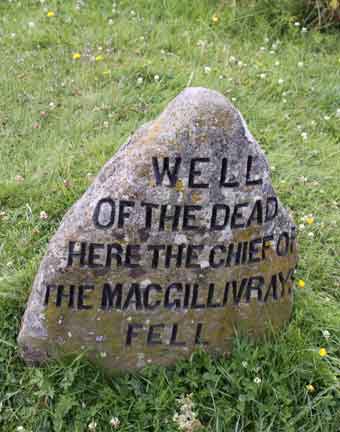 Efforts were subsequently taken to further integrate the comparatively wild Highlands into the
Efforts were subsequently taken to further integrate the comparatively wild Highlands into the  Kingdom of Great Britain; civil penalties were introduced to weaken Gaelic culture and attack the Scottish clan system. The scots fell to piece once more when Cass Pennant and the ICF took over Hampden Péark but thats another story.
Kingdom of Great Britain; civil penalties were introduced to weaken Gaelic culture and attack the Scottish clan system. The scots fell to piece once more when Cass Pennant and the ICF took over Hampden Péark but thats another story.
 Efforts were subsequently taken to further integrate the comparatively wild Highlands into the
Efforts were subsequently taken to further integrate the comparatively wild Highlands into the  Kingdom of Great Britain; civil penalties were introduced to weaken Gaelic culture and attack the Scottish clan system. The scots fell to piece once more when Cass Pennant and the ICF took over Hampden Péark but thats another story.
Kingdom of Great Britain; civil penalties were introduced to weaken Gaelic culture and attack the Scottish clan system. The scots fell to piece once more when Cass Pennant and the ICF took over Hampden Péark but thats another story.
No comments:
Post a Comment